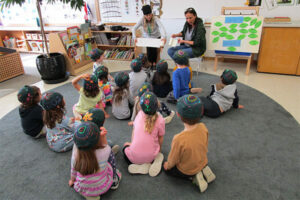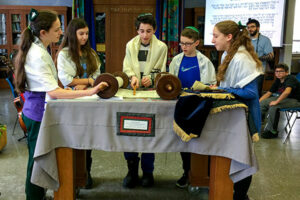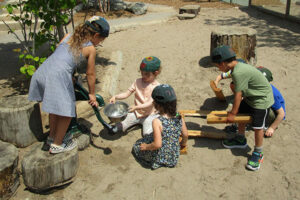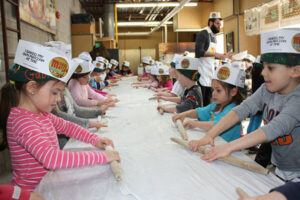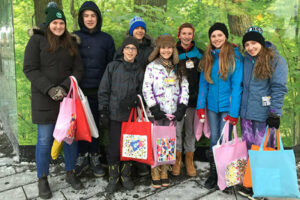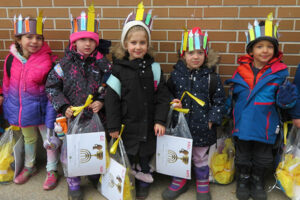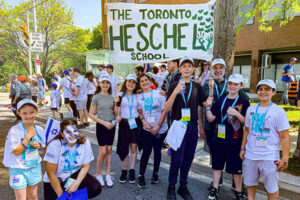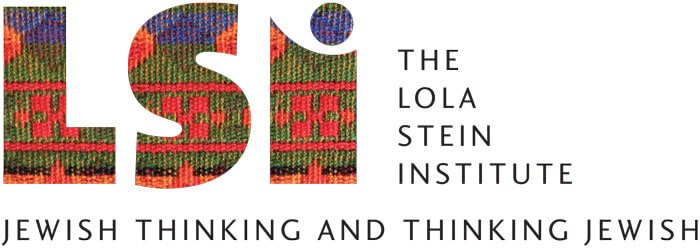- How We Teach

- First Column
- Second Column
- Third Column
- Case Studies

- First Column
- Second Column
- Culture & Community

- First Column
- Second Column
- News & Views

- Admissions

- First Column
- Second Column
- Support Us

- About

- First Column
- Second Column
- Parent Hub
- Attend an Open House
- Take a Tour
- Donate Now
- Calendar
- Blog
- 416-635-1876
- Search
Invisible Thread: Did you Know that Chevra Means a Circle of Friends?
by
Usually we look at schools to see what’s happening with the children. But what do we learn if we look at what is going on among the adults?
We are aware that things happen that aren’t visible to the children. They’re rarely aware of the planning and co- ordination that support a household or the late-night and early-morning conversations between adults. They don’t see their teachers’ preparations or collaborations or the running dialogue among parents and caregivers about schedules, drop-offs, pick-ups, meals, and supervision. Children are usually oblivious to the myriad of forces that go on behind the scenes.
Meanwhile there are also things about our school that are invisible to parents. Once the kids go through the front doors of the school they are, often for the first time in their lives, navigating life without us. They bring home finished artwork that we haven’t seen them create. They bring home tests for us to sign and poems for us to read that we didn’t watch them write. Suddenly we realize that our children know things, they know a lot of new things, but we don’t know when or how they learned them. But we’re good with that. We’re at this school because we want them learning through the arts in an interdisciplinary, high-achievement curriculum. So whatever is going on in there, we’re glad.
But there’s more. There’s a lot going on at our school that is outside the academics, invisible to most parents, but part and parcel of our children’s experiences. When Toronto Heschel opened 25 years ago, it was imagined as a holistic fusion of high-level learning and a deep acculturation for living Judaism; it was mind and body and soul. It entailed a multidimensional outlook that blurred traditional boundaries between in school and out of school, and the founding educators and parents imagined forging a new kind of dynamic between all the people involved in this new kind of school.
Echoing the interdisciplinary structure of the curriculum, the extracurricular realm would also be intensely integrated. The Heschel parents strove to live their beliefs, or to quote Rabbi Heschel, the school’s namesake and inspiration, “pray with [their] feet.” Rabbi Heschel’s famous description of his participation with Martin Luther King Jr. in the Civil Rights march from Selma in 1965 as praying with his feet reflect- ed his deep religious conviction in the search for justice; he had to live by his beliefs. The Toronto Heschel School’s founding intention was not just to educate the minds of children but to show them how to walk the walk. This brought in Rabbi Heschel’s preference for “text people” over textbooks. Role models are the best educators, whether faculty or family.
To this end, the Heschel School requires an activated culture and, for this, it relies significantly on the volunteer energy of its families. Enter the Chevra Committee of the Toronto Heschel Board of Directors. It’s important here to note that chevra is the Hebrew word for friendship; the word for community is kehillah. The school and its Board understand that a community grows where friendships are real. Maybe the envisioned chevra—circle of friends—is the school’s feet and maybe it’s the heart; whichever metaphor works, the aspiration is the whole child, the whole school, the whole family.
The Chevra Committee—variously called the “chevra elves,” “the lifeblood of Heschel”—is one of the most essential components of the invisible infrastructure that makes Heschel what it is. The direction that the Committee took over the years wasn’t to ramp up the usual home–school dyad but rather to create a sense of home at school. The Committee’s investment in the school’s philosophies and the way it bridges curriculum and extracurricular go far beyond the usual PTA bake sales and carnivals.
As the school got bigger—43 students in 1996 and over 300 today—the Committee’s agenda, of course, became complex. Yet the Committee has not lost its sense of purpose. In fact, with a larger and more diverse community, its mission is even more crucial. It is not a fundraising organ of the school; its eyes are on social currents, Jewish manifestations, and attitudes; it keeps the home fires burning. Just as the values lived at home inform who a child becomes, the way a school deports itself has an impact on how each student develops.
Simply put, the goal of the Committee is to celebrate, activate, and reaffirm outside the classroom the values that animate what’s going on inside the classroom. The cornerstone cultural values of the Heschel School are Jewish inclusivity and pluralism, ethical living, environmental stewardship, and social justice. They are embedded in integrative thinking— call it multitasking—and they are guided by the inspirational compass that is living with awe and a sense of wonder, again inspired by Rabbi Heschel’s philosophies. Practically speaking, it means that whenever the Committee organizes an initiative, the school’s ethics and values shape the event.
This is not to say that families and teachers don’t gather just for fun, the point is there is always a purposeful “Heschelian” intentionality in how we gather. A good example is the waffle breakfast in the school’s Sukka that welcomes newcomers and returning families alike after the summer break in the spirit of hospitality, which is central to the holiday of Sukkot. For years we’ve taken advantage of three stars showing early in the winter sky to celebrate the end of Shabbat together at a skating party called Havdalah on Ice. Because Heschel families practice religious observance differently at home, we ensure everyone feels comfortable when we’re together and maintain the halakhic threshold especially for kashrut, Shabbat, and holidays. We also flatten financial barriers so all school families can participate fully.
Perhaps the school value that gives Heschel events their most characteristic shape is our steady respect of “awe and wonder.” It is because the Toronto Heschel School believes that each child should authentically experience their surroundings that our events eschew technologies and equipment that tend to obstruct the immediacy of experience. No bouncy castles, for example, or laser-light shows or virtual reality.
Until I began to explore the whys and wherefores of the Chevra Committee, I couldn’t see this thread that weaves through my children’s school experience. I didn’t put it all together. Now I do, and now I see it wherever I look.
Ava Kwinter studied English literature at McGill University, Queen’s University, and the University of Ottawa.
Perspectives
 The Lola Stein Institute (LSI) is a centre of inventive educational thinking and addresses the challenge to re-frame schooling for the exigencies of our times.Home > THINK Magazine > Spring 2021 > Invisible Thread: Did you Know that Chevra Means a Circle of Friends?
The Lola Stein Institute (LSI) is a centre of inventive educational thinking and addresses the challenge to re-frame schooling for the exigencies of our times.Home > THINK Magazine > Spring 2021 > Invisible Thread: Did you Know that Chevra Means a Circle of Friends?

